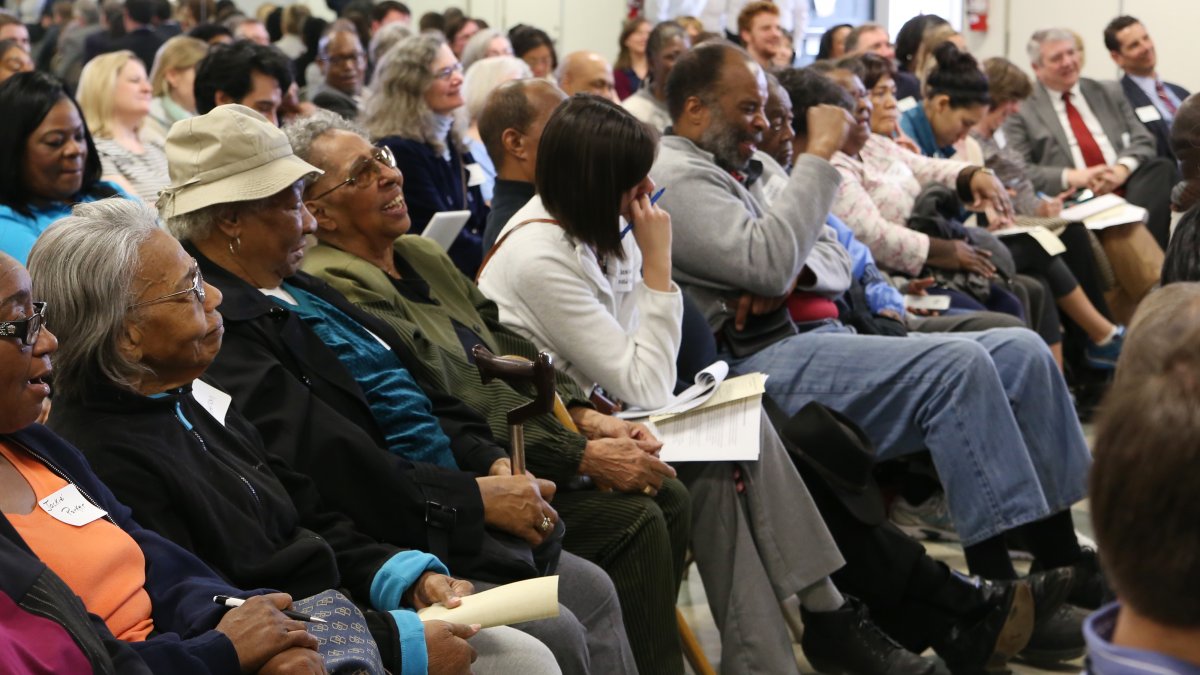Supporting the Northside Neighborhood Initiative
Chancellor Carol L. Folt said she knew Northside was a top priority for the University even before she took the job.

Calling the University the “catalyst” of the Northside Neighborhood Initiative, Chapel Hill Mayor Mark Kleinschmidt announced March 9 that Carolina is making a $3 million, 10-year, no-interest loan to help stabilize the traditionally African-American neighborhood.
About 100 residents, University and town staff, politicians and even some toddlers clapped and cheered their approval at the event, held in the heart of Northside at the Hargraves Center.

Esphur Foster, Northside resident; Michael Palmer, Outreach Coordinator for Self-Help; Chancellor Carol L. Folt; Chapel Hill Mayor Mark Kleinschmidt; and resident Kathy Atwater at the announcement of the Northside Neighborhood Initiative, a partnership between the University of North Carolina at Chapel Hill, the Town of Chapel Hill, Self-Help and the Marian Cheek Jackson Center.
The initiative is a partnership of the University, the town and two nonprofits, Self-Help and the Jackson Center. Self-Help, a Durham-based community developer, will manage the $3 million loan to achieve these shared goals: helping longtime residents stay in their homes; attracting new residents from diverse backgrounds; and increasing the availability of housing and financing options for neighborhood properties.
Chancellor Carol L. Folt said she knew Northside was a top priority for the University even before she took the job. On one of her campus visits, a trustee drove her around the neighborhood, and the mayor brought up the issue when she had dinner with him on her second day as chancellor.

Chancellor Carol L. Folt meets with residents following the announcement of the Northside Neighborhood Initiative, a partnership between the University of North Carolina at Chapel Hill, the Town of Chapel Hill, Self-Help and the Marian Cheek Jackson Center.
“UNC-Chapel Hill not only wants to be a part of this initiative, it must be a part of this initiative,” Folt said, adding that the University can only be as strong as the communities around it.
Northside, 188 acres north of Rosemary and west of Columbia streets, has historically been the largest African-American community in Chapel Hill. Originally called Potters Field, Northside was established more than 100 years ago as a home for University employees that was within easy walking distance of campus.
“They went to work, come rain or shine, so the University was never closed because of inclement weather,” said Esphur Foster, a longtime resident of Northside who spoke at the event.
She and other residents recalled a place where children minded their elders, related or not, a tight-knit community where people watched out for each other, where couples brought up their children and their grandchildren.
In a short slide show at the beginning at the event, Northside Elementary fourth graders expressed their dreams for the neighborhood, including a shop where they could buy snacks. This wish reminded longtime resident Kathy Atwater about sharing treats from her uncle’s neighborhood store with “my friends and those who wanted to be my friends” at school. “Their dream of what Northside should be – that’s what our reality was. It wasn’t a dream. It was a reality.”

Resident Kathy Atwater welcomes guests at the announcement of the Northside Neighborhood Initiative, a partnership between the University of North Carolina at Chapel Hill, the Town of Chapel Hill, Self-Help and the Marian Cheek Jackson Center.
From 1980 to 2010, the black population of Northside decreased by about 40 percent. As longtime residents moved away or died, developers snapped up this prime real estate at bargain prices. They converted single-family homes into rental units or tore down the houses and built new units, rented mostly to college students.
In the last decade, the town and Northside residents have tried several methods of stabilizing the community: establishment of a Neighborhood Conservation District; a development moratorium; a community plan shared with Pine Knolls; a housing market action plan; zoning regulations; and code enforcement.
“We’ve tried a lot of different things,” Kleinschmidt said. “But they were just targeting the symptoms of the change and not really the heart of how the change was happening.”
Taking that next step, though, required greater town, gown and neighborhood collaboration and the resources to carry out the strategy. The initiative brings together the key players, and the University’s loan provides the funding to establish a “land bank” as properties become available.
Michael Palmer at Self-Help thanked Folt for her leadership. He added that a similar program he was involved in, the Duke-Durham Neighborhood Partnership, got underway because of the efforts of another woman who was an institution’s first female leader, Duke University’s President Nan Keohane. “There’s something about that maternal instinct,” he said.

Michael Palmer, Outreach Coordinator for Self-Help, makes remarks during the announcement of the Northside Neighborhood Initiative, a partnership between the University of North Carolina at Chapel Hill, the Town of Chapel Hill, Self-Help and the Marian Cheek Jackson Center.
On a more serious note, he lamented that the neighborhood in Rhode Island where he and his friends grew up “no longer exists. All we have left are memories.”
Northside resident Teresa Shaw seemed confident this wouldn’t happen to her neighborhood after the announcement of the initiative and the University’s loan.
“This is the greatest thing that could have happened,” she said.




